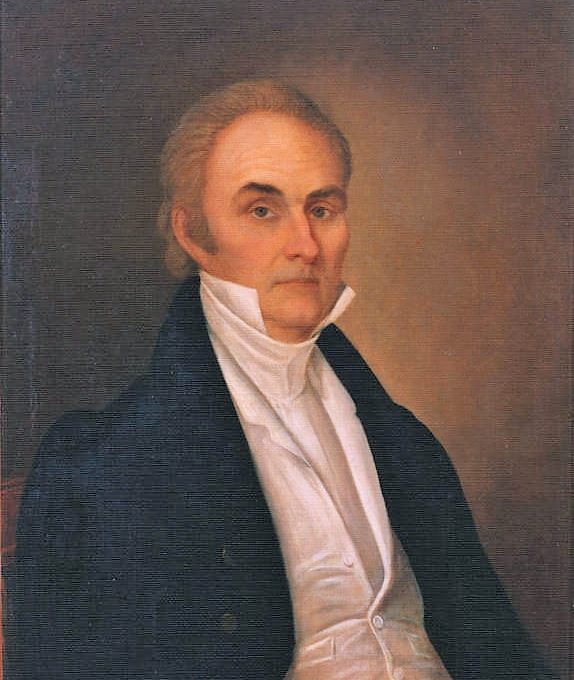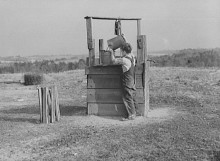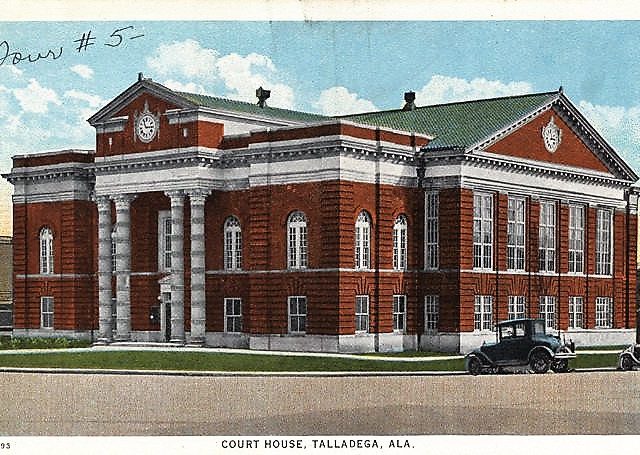JOURNAL OF JAMES A. TAIT FOR THE YEAR 1813.1
(Diary entries from the 25th of August 1813 to the 25th of March 1815). Edited by Peter A. Brannon
James A. Tait was born at Cokesbury College, Maryland, September 8, 1771) He died on his plantation at Dry Forks, Wilcox County, Alabama, February 10, 1855. Mr. Tait came to the Alabama territory about two years after his service against the Indians. Judge Charles Tait, his father, one time Senator from Georgia and recently appointed Federal Judge in the new District, followed his son to the Lower Alabama country. Judge Tait as well as Doctor William W. Bibb, the Junior Senator from Georgia, both failed of reelection when the question of payment for representation in Congress came up. Both the former Georgians received Federal appointments. Doctor Bibb was the first and only Territorial Governor of Alabama.
Portrait of Charles Tait, the first federal district court judge appointed in Alabama (Alabama Department of Archives and History)
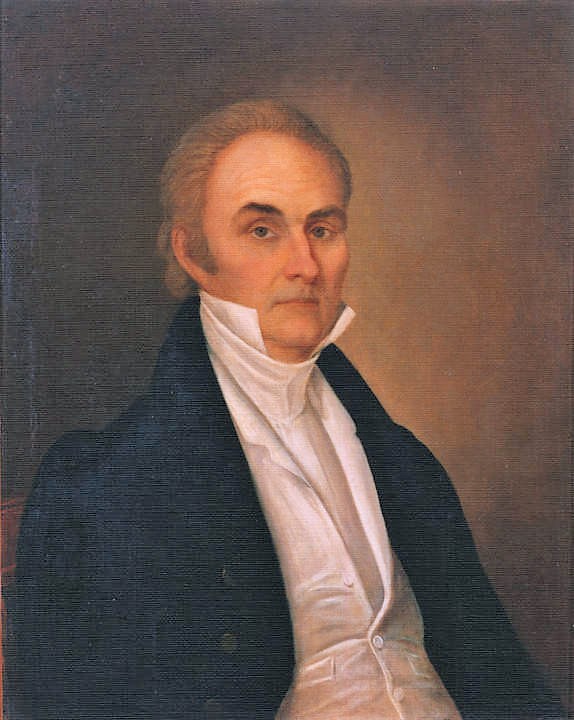
The manuscript collections of the Alabama Department of Archives and History contain a considerable correspondence of Judge Tait as well as the plantation records of James Tait. There is also in the Department quite a few relics of the family. Judge Tait was a patron of the Philadelphia Academy of Sciences. The Tait family of Wilcox County were extensive planters holding large bodies of land in the Alabama River Valley.
There are many descendants living in that country today. The Journal exactly as set-out by James Tait, a Private soldier follows:
Journal
By
Jas. A. Tait for the year 1813.
Capt. Smith’s company, of which I am one, met on Wednesday at Elbert C. House, and started on a military expedition against the Creek Indians.
Left home on horseback the 27th overtook our company one mile from Greensborough, walked 9 miles first day after leaving our horses 16 miles from Lexington. I walked 20 miles the second day. The farthest I ever walked in one day on a journey, and slept at Eatonton, a few miles ahead of the com. On Monday night encamped 15 miles from Eatonton in a most indifferent tent, without any detriment tho.
Thursday night slept in Clinton, in the Church, on a very narrow bench without the ill luck of tumbling off once.
Arrived at the Oakmulgee camp ground about 3 o’clock on Wednesday after the company had marched for 7 days through very rainy weather; being very warm also. As soon as we reached the place of Westington we struck up a miserable shelter, which was put to a severe test, by a hard rain descending upon it the very instant of its erection. It could not defend us. We got a disagreeable, tho not a perfect wetting. We made gradual improvements. This little army has been badly provided with victuals since it encamped. Much and just complaint has arisen; I hope we shall be taken more care of in this way for the future. There has been considerable bustle about an election for a Col. commandant of this regiment. If there should be an election, it would cause great delay, and trouble; it is said we should return to our counties to vote. This would never do. How the affairs will terminate I do not know. I write this on the 3rd.
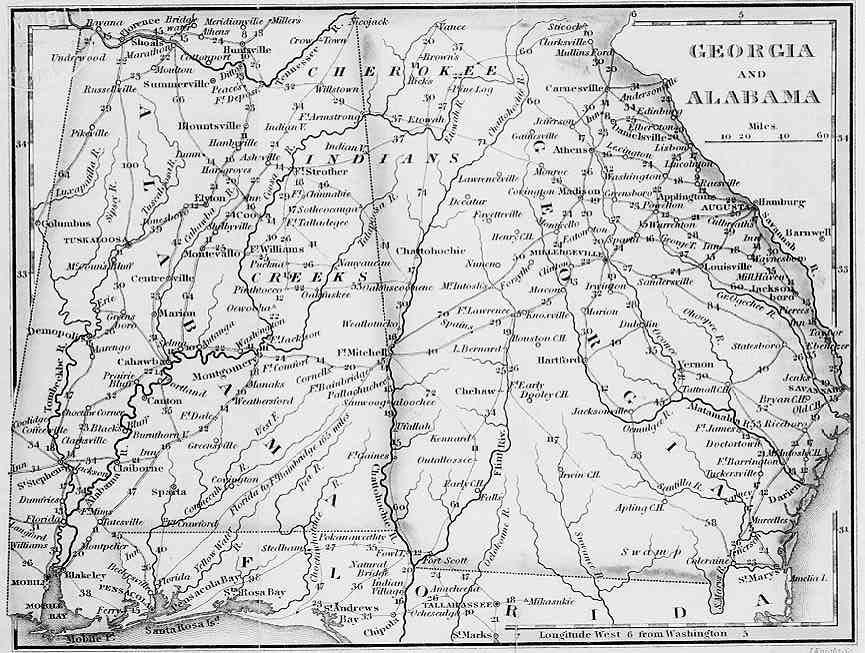
Capt. Cunningham with his company of 111 men, and 50 horse, moved off to Hawkins’ on the Flint River,2 on Monday 6th.
Harris’s regiment drew their arms, at the fort on Tuesday the 7th.
General Floyd & suit paid his first respects to our regiment on Thursday the 9th. He was dressed in a blue frock coat, with very splendid epaulets and rich gold lace. He is a man, of statue, about the middle size, of a dark complexion and formed for strength, appearing to possess the capacity, so necessary for a commander, of enduring much fatigue. He was received by the regiment, in the usual stile, with their arms presented, drums beating and fifes playing; being conducted in by the adjutant. He walked between the two battalions being about 40 paces apart, with his head inclined to the left, and looking altogether to the right battalion. Adjutant Gen. Newman is with us occasionally. I expect that he is the most able, or skillful, commander in the southern country; very nimble in the field, possessing great presence of mind, and delivering his orders with great precision, accuracy, and distinctness. Jenkins and Harris’s regiments are said to be composed, the former of about 17 hundred men, the latter of about 9 hundred, infantry besides about 5 hundred of cavalry. When we shall march against the Indians is not known, probably in 5 or 6 weeks. Matters are not yet well organized. Officers in the contracting or victualing department must give better proofs of their activity and management, or perhaps we should not in 3 months, move to the object of the expedition. Orders were issued this morning prohibiting of prophane swearing &c. under penalty of the guard houses; alias imprisonment.
10th Sept. 1813
J. A. Tait.
Two men from Porters’ and four from Clevelands’ deserted yesterday morning 9th. The first unhappy instances of the kind.
Stood as one of the picket guard second times in the night from 5 to 7 o’clock, from 11 to 1, from 5 to 7 in the morning of the 13th being number 19, second relief. The guards were distributed into 3 reliefs, of 20 men, each standing 3 hours in 29. Our two countersigns were, and hard times. The cotton very appropos.
Moved to the lower encampment, situated on the right bank of boggy branch in the piny woods. An express reached camp from the Agency, bringing news that the Garrison of Fort Mims had been cut off by the Indians. Melancholy news. 17th.
The Artillery company returned to Milledgeville. 17th. The poah (corn) fields upon the Oakmulge, are said to have produced 75 bushesls per acre. 15 barrels. Col. Harris proposed to make me his clerk: I declined for the reasons, first it was entirely unexpected, 2nd I had reconciled it to my mind to serve my country as a dutiful citizen in arms, estimating it honorable to fight for one’s country, pro patria puguine aut nois; 3rd I had formed attachments to my mess; and not caring for any favor that Col. Harris could bestow.
A private in Capt. Heath’s company died last night. The first sad instance of the kind, which has occurred in this encampment.
The first frost at Camp Hope on the 12th.
Another death of one Paxon the 18th.
Took a joyfull farewell of the sweet waters of boggy branch on the 29th at about one o’clock.
Arrived at the Agency on the evening of the 1st after a tiresome day’s march through the woods on the right flank commanded by Major Jones. Waded Flint river next morning like a soldier and encamped on the plain of Fort Lawrence. The next 3rd day marched into the Fort as garrison and took the place of Capt. Merriwether. Five good companies, at least are requisite to defend the fort in case of attack by a formidable force. The fort is 180 feet square, 2 block houses, 2 hospitals, 2 store houses for provisions, etc.
The army marched from Ft. Lawrence on 18th for Coweta, leaving a garrison composed of the companies of Caps. Smith & Ware and about 250 sick men. The diseases with which the army has been afflicted have their origin in bad colds, thence in violent headaches, fevers, debility and death. The course of F. Lawrence from Ft. Hawkins is South 70 degrees west, distance 30 miles. From F. Lawrence to Chitta Hoodie 58 miles, from thence to the Ottise town about the same distance the last town about 25 miles above the junction of the Coosa and Tallapoosa and situated on the latter river. The town called Oakfuskee about 20 miles above Ottesee on the same river. The Coweta and Cusseta towns are on the banks of the Chitta Hooche3 7 miles apart, the former above.
Some particulars of the battle on the Tallipoosa,4 fought on the 29th Nov. under the command of Gen. Floyd on our part. After three days march, the army, (18 hundred strong, including 500 Indians, besides 8 hundred infantry, 200 cavalry, 200 riflemen and an Artillery company of 100 men); encamped on the right of the 28th within 8 miles of the Ottesee town the place of battle. The next morning it marched so soon as to exhibit itself to the surprised and astonished Indians, about half way between clay break and sunrise; at this period the contest commenced. Then, for the first time, we heard to resound on the remote banks of the Tallapoosa the dreadful noise of contending armies, never before did the limpid waters receive the tinge of human blood. The battle lasted 2 and a half or 3 hours. 9 of our men were slain on the fields, some say 100, some 200 and some 300 of the enemy. They retired behind the bank of the river and as they were shot rolled into the stream, and were also derived into it to prevent the efforts of the scalping knife. Some were killed in swimming across. It is supposed that between 1500 and 2000 of the enemy were engaged. 3 of our wounded died after the conflict. Capts. King, Little and Morise (Sic.) were wounded. The brave Adjutant Gen. Newman and our brave and respected Gen. Floyd, the latter having his knee pan broken, the former slightly in the leg. There were 18 rounds of canon fired shattering their miserable huts to pieces. The enemy stuck close to their houses before this, through holes which were cut, firing upon us. When the big guns were let loose, they left their huts and scampered like so many wild ants, some arts of their conduct were truely strange, several of them remained in their houses quite passive during the battle, suffering themselves to be slain without resistance. Whether was this the effects of prophetic influence? There were but few of them who were not in a state of complete nudity. Whether from necessity or choice I cannot pretend to say. Why from the former? for where are their dressed dear skins. Why from the latter? for it was very cold. Two of their kings shared the fatal portion of many of their subjects. The old Tallisee king mounted a horse from whence he encouraged his warriors by frequent waivings of his war club, himself firing upon us, at intervals with his rifle. Being discovered by Capt. Thomas, of the artillery, a cannon was directed towards him—charged with grape shot, one of which took effect in the neck of the brave old king; the club no longer felt the grasp of its war like possessor. Parker is said to have killed 3 or 4 of the enemy. Old Major Montgomery slew one and aided in the slaughter. The victory, in my opinion, was mercy was relieved, mercy was asked by some of the poor devils, but none shown.
Two hunderd of our men at Coweta were on the sick list Dec. 7th.
The common calculation, as to the number of warriors in the Creek nation, falls very short of the real number. It is ascertained that there are at least 9000 fighting men 3400 men of the friendly party reported themselves to Gen. Floyd the other day. The common estimate has been 5 or 6000. Fort Mims5 was situated on this side of the Alabama near its mouth.
Abandoned Fort Lawrence to Capt. Twigg’s company on the llth Jan. and arrived at Fort Mitchell on the sixth day from the day of march, part of the time was disagreeable on account of the rain.
Marched for the Tallapoosa on the 17th Arrived at fort Hull6 on the 20th
After four days work on this fort it being in a good state and fit for defense against any enemy that might be expected to assault it, the army marched on towards its destination, Toochebatche old fields on Tuesday the 25th. Marched about 3 miles that day; just before we encamped, our leaders by their movements and by the evolutions of the columns instilled into us a belief that we were here to have battle. My regiment was on the left, and my company on the left of that but one. When the line was formed our front had fallen upon a swamp, here we fully expected to hear the rifles of the Red Clubs. The friendly by Indians on our left flank, having the same anticipations, blacked themselves, their faces, at some burnt lightwood stumps and logs. This is their way, in order to exhibit to their enemies an ugly an appearance as possible. As it turned out we were all agreeably disappointed, it was all show. This though was induced to inspire our commanders with some confidence in us. It had no bad effect. Next morning, it being the 26th we struck up the line of march early. Moved on about a mile and a half, struck off to the right into the woods, marched a mile, halted, faced about, (the Genl. having resolved to send back the wagons by which we were retarded) and marched back about 3/7ths of a mile to the ground on which we encamped. At this camp the next morning the 27th we were attacked by the enemy, before day about one half hour; the battle raged for about 3/4th of an hour when we charged upon them, drove them off, and killed several. Capt. Hamilton’s troops of horse slew 15 in the charge. Our loss was 17 in killed and 132 in wounded. The number slain on the part of the enemy was ascertained to be about 50. The camp was too small, the men being two deep in line when drawn up to our camp. At the time of attack we had to draw in behind our fires, which made the lines still closer. If the camp had been fortified, to do which we had ample time, we should not have had 20 men in killed and wounded. We were on the battle, ground six days in an entrenched camp. Thence moved down to Fort Hull on the 1st day of Feb. Thence on our return march for home on the 16th Feb. We reached the Oakmulge on the 26th. Thence were conveyed to Milledgeville and not discharged until the 7th March I speak now of our regiment. The other was not discharged perhaps until the 15th.
The friendly Indians, who were with us, exercised great barbarity upon the bodies of our enemies slain, on the morning after the battle. They riped them open, cut their heads to pieces, took out the heart of one, which was borne along in savage triumph by the perpetrators; and strange to tell, cut off the private parts of others. What bestial conduct!
One dead Indian was hoisted upon a dead horse and as he would tumble off, the savage spectators would cry out “Whiskey too much.”
The men began to be quite sickly at Ft. Hull on account of the exposure at Camp Defiance.7 Dirty clothes, frequent night alarms jumping up in the cold and standing in the ditch for some time in consequence, and had water together with loss of sleep and getting wet as we were going down to the fort, are the causes of the sickness which prevailed; for we must always account for these things. There were three men in our company who behaved dishonorably, as it was said, B. Blackwell, Burley Andrew and Jesse Nash. I am sorry for this, there are men of this cast tho in all armies, it is natural, all men are not alike. Tot homines, tot sententiae et facilitates. The charges against Col. Smith were 1st for disposing of public stores, powder, ball and blankets, 2nd ungentlemanly conduct in making the soldiers butcher beeves and appropriating the hides to his own use. 3rd granting a license to noncommissioned officers to retail spirituous liquors in Fort Lawrence. He was dismissed the service a few days before we left the advanced post; the charges having been substantiated. I have written these last notes this 21st day of March 1814 at home depending upon the correctness of my memory as to the facts stated.8 Jas. A. Tait.
1The original Journal of James Tait is a handmade, paper covered, little volume ruled so that the date of each changing incident appears to the right. Besides an interesting account of his experiences he has injected Indian words, some short sentences and common expressions. The volume was presented to the Alabama Department of Archives and History by Mrs. R. Spencer, September 28, 1901.
2Hawkins’on the Flint River. This refers to Colonel Benjamin Hawkins’ residence in the present Crawford County, Georgia on Flint River, this being the site of the United States Indian Agency among the Creeks. Colonel Hawkins, a native of North Carolina, attended Princeton, was a staff officer in the American Revolution, was a senator from North Carolina, and was the United States Agent among the Creeks from 1798 to 1816 having had an appointment under George Washington as a Commissioner to the Indians prior to that time. The site was on the Federal Road which went that way from Milledgeville to Fort Hawkins, the present Macon, Georgia, thence by Fort Mitchell and into the Indian country.
3Chitta Hoochee is the “Chattahoochee” River – Ottissa is the Indian town generally designated “Ottassee”, a location half a mile southwest from the mouth of Calebee Creek in the present Macon County, Alabama.
Oakfuskee is the site of the old British port, Fort Okfuski, opposite the influx of Sandy Creek (from the West) into the Tallapoosa River. The distance is considerably more than twenty miles above Ottassee. The location is in Tallapoosa County about twelve miles west of Dadeville. The Coweta and Cusseta towns are in Russell County, Alabama and Stewart County, Georgia respectively. Coweta was two miles northeast of Fort Mitchell. Cusseta was in the present Fort Banning military reservation just south of Upatoy Creek. This was the largest town in the Lower Nation in population. The Federal Road crossed here. A trail branched up to Coweta town which was not on the main Federal Road as cut in 1811.
4The “Battle on the Tallapoosa” is a reference to the battle of Ottassee, which took place south of the mouth of Calebee Creek and a little northwest of Shorter Station on the Western of Alabama Railway. Aboriginal evidences would indicate that this is a very old settlement site. A considerable mound is still there. William Bartram, the celebrated American naturalist, was at this place during Christmas week of 1777, and notes in his journal the only totem pole ever referred to in the southern States. The town house here was one hundred feet in diameter according to his records, and archaeological investigations several years ago showed that the posts of this building are still in place underground. Colonel Benjamin Hawkins, United States Agent for Indian Affairs South of the Ohio, spent Christmas day, 1796 in the home of James Bailey at this place. Oixon Bailey and his brother Richard, sons of this man, were educated in Philadelphia. One of them was under the tutelage of the Quakers and the other one sponsored by the United States government. Elizabeth, who became Mrs. Fisher, learned to read and write in one of the families in the Tensas Country on the lower Alabama.
5Fort Mims was located just south of the Cut-Off, on the Alabama River. The site is in the present Baldwin County. It was a stockaded post erected around the home of Sam Mims, and was garrisoned on August 30, 1813, when the massacre took place, by several companies of local militia, and some regulars, and some Mississippi volunteers all under the command of Major Daniel Beasley. The massacre on that occasion was prompted by William Weatherford but he did not take part. Nearly five hundred white settlers, including men, women, and children, and some negroes were killed and most of the bodies were burned. This site has had an interesting association with Alabama history. On Boatyard Lake two miles away was Pierce’s school and gin. They dated as early as 1803. After the massacre and when Mrs. Mims, who was not present at the time of the uprising, had gone back there to live, she was visited by Mrs. Andrew Jackson who notes this fact in letters written from Montpelier, the home of David Tate some twelve miles northeast
6Fort Hull was located on 1»he Federal Road four and one half miles southeast of the present Tuskegee and there is today at that place a negro church and school known as the Fort Hull School. It is on the Russell plantation. The stockade* mound post was garrisoned for some time in 1813-14 by a company oi militia from Putnam County, Georgia under Captain John Broadnax and a company from Franklin County under Lieutenant Adaroin. Captain Twiggs of the United States Army, later the celebrated General of the name, was in command.
7Inasmuch as there is not a reference to the army crossing the Tallapoosa River, the site of this place must be near the mouth of Calebee Creek and adjacent to the old town site. General Thomas Woodward says that the battle of Calebee was fought a short distance from the present Union Methodist Church. The reader should see references to these points in Woodward’s Reminiscences, where a full account of both the battle of Otossee and Calebee may be seen. Near Tysonville between Cuba and Calebee Creeks and on the South side (East), of the Tallapoosa, during the high waters of the river in 1919, a large number of burials were washed out, and these were accompanied by buttons. This might indicate that a number of Indian soldiers killed in the fight were buried there
8Floyd’s night fight on Calebee occurred quoting Woodward on the march West from Fort Hull and North of what was then known as the Federal Road from Milledgeville in Georgia to Fort. Stephens in the Mississippi Territory. After the fight the Georgia army returned to Fort Mitchell, and most of them went home. From Fort Mitchell Colonel Homer V. Milton, of the Third United States Infantry, who had been left in command at Fort Hull, proceeded west to a point opposite Tuckabahchi Old Fields and, erected in January, 1814 Fort Decatur on a high bluff of the Tallapoosa River near a place now known as Milstead. The location is where the Western of Alabama Railway runs very near the River. The embankments and earthworks of Fort Decatur are today as intact as when thrown up. The site is marked with a boulder which has befell superimposed with a tablet, erected by the Alabama Anthropological Society, and dedicated with auspicious exercises participated in officially by the States of Georgia and North Carolina. Fort Decatur was erected by troops of the Seventh North Carolina volunteers. President James Madison sent former Governor John Sevier, a veteran of the American Revolution and the hero of King’s Mountain, to Fort Decatur in the Summer of 1815 as the boundary line commissioner to run the line between the Creek Nation and the Mississippi Territory in accordance with the Treaty of Fort Jackson. General Sevier died the day after his arrival and his remains were at this place until they were exhumed and carried back to Knoxville in 1888. Other Georgians who participated in the engagement at Calebee included Captain William Butler, a native of Virginia, but who had served in the Georgia Legislature, and Captain James Saffold, who commanded a company of artillery connected with the outfit of Major William Mclntosh. The Saffold family has been long prominent in Alabama State history. Captain William Butler was killed in an Indian uprising in 1818 within the territory of a present day Alabama County which bears his name.
ALABAMA FOOTPRINTS Banished: Lost & Forgotten Stories
ALABAMA FOOTPRINTS Banished
reveals true stories, documents and news articles from this sad time in Alabama’s history. Some stories include:
- Choctaw & Treaty Of Dancing Rabbit Creek
- Private Contracts For Removal
- Stockades In Alabama
- The Long Trail West
- Reverend Daniel S. Burtrick’s 1838 Journal
- An Observer Writes His Memories


